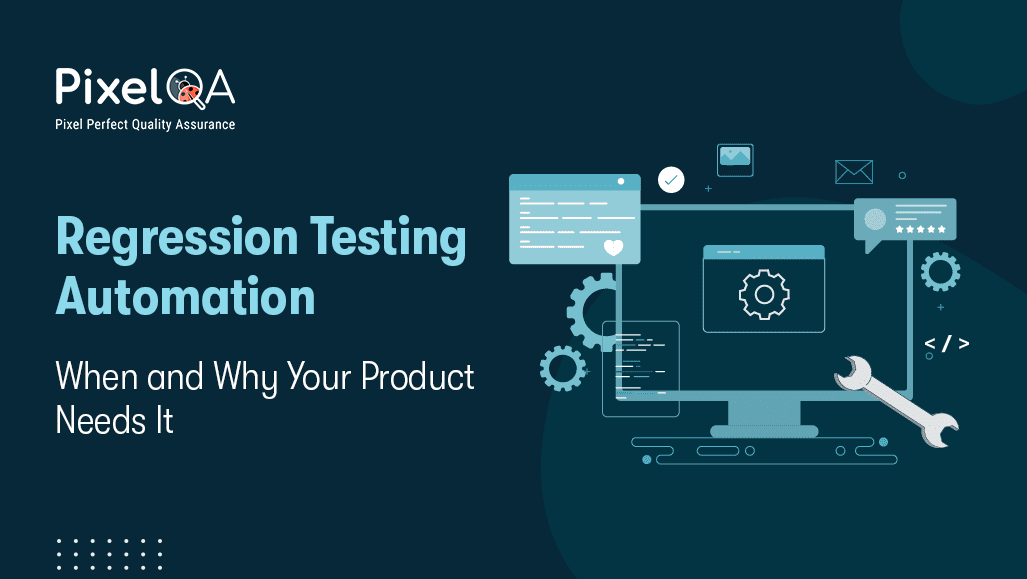
Table of Contents
You've just rolled out a new feature that's been highly requested by customers. The room is filled with excitement until reports start coming in about how existing functionalities are now broken. The login page no longer opens, and the payment gateways glitch. An experience once stable becomes frustrating for users as your team scrambles to find out what went wrong.
This is every product leader's nightmare: new code breaking old features. It's a classic case of regression, a silent disruptor of customer trust and development velocity. Some of it will be caught by manual regression testing. But generally, it is too slow, inconsistent, and expensive for today's release cycles. And that's where automation in regression testing becomes not just an advantage but an important necessity.
This is where it makes sense to bring in professional regression testing services — experts who can take care of the repetitive testing, so your in-house team can focus on building new features.
Understanding Regression Testing
Regression testing is a way to ensure that changes made recently to the code have not damaged functionality. It's a means of making sure that everything from core workflows to minor user interface behaviors continues to work as it should after every update, enhancement, or bug fix.
Manual regression testing involves testers re-executing old test cases repeatedly, which is a very unscalable practice when the growth of the product increases. Using prewritten scripts and tools to run the tests quickly and steadily across different environments, automation reduces human error to a great extent and accelerates the release cycles, which acts as the prime factor for agile and continuous delivery environments.
When Manual Testing Falls Short
When you're just starting or working on something small, doing tests by hand is probably okay. But as your product grows, doing all that regression testing manually can eat up resources and slow things down. You'll notice the signs when:
- Release cycles slow down because testing takes longer than development.
- Test coverage becomes inconsistent, with different testers prioritizing different scenarios.
- Human fatigue leads to missed bugs, especially in repetitive test cases.
- Your QA costs escalate, but quality still fluctuates.
- Frequent hotfixes after deployment begin to erode customer confidence.
If these sound familiar, it’s time to consider regression test automation.
Why Automating Regression Testing Makes Business Sense
Automation is about helping teams concentrate on the important stuff — all while keeping the product stable as it grows. Here's why it makes strong business sense to start using it:
1. Accelerated Time-to-Market
If you set up your automated regression tests to run each night across different browsers, devices, and operating systems, you can get feedback much quicker. This means you can make changes faster and cut down release times from weeks to just days. Getting things done fast isn't just about being efficient; it's about staying in the game.
2. Enhanced Product Quality
With automation, we run all our tests all the time, so we don't miss anything important. This means fewer problems after we release the product. Which keeps users happy. Happy users stick around, and that protects our good name.
3. Cost Efficiency Over Time
Automation frameworks, though costly in their initial setup, yield high returns in the long run. Each test case that gets automated can be reused in numerous releases. In fact, it can reduce the regression testing cost significantly — up to 70% over time. The result? More predictable budgets and reduced dependency on large teams for repetitive testing.
4. Improved Team Productivity
Automation of testing in a CI/CD pipeline enables developers and QA teams to better collaborate. Instead of spending days on repetitive manual tests, QA engineers can focus on exploratory testing, usability assessments, and strategic quality improvements.
5. Scalability and Consistency
Automation brings uniformity. No matter if your product has 50 or 5,000 test cases, automation makes sure tests are run and reported the same way every time. It's what you need to grow your quality assurance as your product gets bigger.
When Your Product Needs Regression Testing Automation
Not every organization needs to automate everything right away, but certain triggers make it an ideal time to start:
- Releasing Often: If you're pushing out updates every week or two, manual testing just can't keep up. It slows everything down.
- Big, Complicated Stuff: Products with tons of features that connect to other things or use many APIs need really good checks to make sure nothing breaks.
- Lots of Users: If you have an app or online product with tons of users, you really can't have it crash or have features that don't work.
- Works Everywhere: If your app is on the web, phones, and computers, automation makes sure it works the same on all of them.
- Following the Rules: If you're in finance, healthcare, or e-commerce, you have to test things carefully so you can prove you're doing things right.
The Conclusion
Automation of regression testing is a strategic decision that drives business resilience, customer satisfaction, and faster innovation. By adopting it, you're empowering your teams to build with confidence and deliver consistently high-quality releases.
Whether your organization faces delayed releases, increased QA costs, or recurring issues post-deployment, now is the time to act. Learn how the expert team at PixelQA can help you design, implement, and scale. Begin by visiting PixelQA.com and discover for yourself how leading businesses are redefining quality assurance through smart automation.

